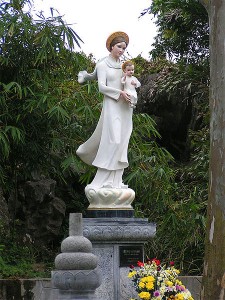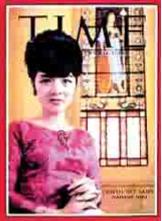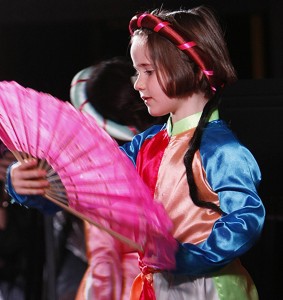WoWasis note: San Jose, California, is essentially the largest Vietnamese city outside of Vietnam, with an estimated 100,000 residents of Vietnamese ethnicity. Each year, San Jose hosts the Ao Dai Festival, celebrating the garment that is the paragon of traditional Vietnamese feminine fashion. San Jose’s Dan Do has written the following article on the history of the Ao Dai:
Truong Quynh Mai in her winning costume
The Vietnamese “Ao Dai”, the long gown worn with trousers by Vietnamese women, has become the symbol of the Vietnamese feminine beauty, and the pride of the Vietnamese people. This national pride culminated in 1995 when Miss International Pageant in Tokyo gave its Best National Costume award to the Vietnamese representative Truong Quynh Mai. Even before such international recognition, the Ao Dai had long been the source of inspiration of artists and poets, and thus had become an institution in Vietnamese arts and literature.
Ao Dai of the Cham people
The Ao Dai was born as the costume required to be worn by the southern courtiers under the reign of the southern lord Nguyen Phuc Khoat. Eager to establish a separate identity from his northern rivals, the Trinh lords, who enjoyed the status of regents to the puppet kings of the declining Le dynasty, Lord Nguyen decreed that men and women of his court wore trousers covered by a long gown. Thus was born the Ao Dai. The garment borrowed the style of clothing worn by the Cham, the original inhabitants of the land to the south of the dividing Gianh river, whose country of Champa (now Central Vietnam) had been invaded and conquered by the Vietnamese. The Ao Dai was Lord Nguyen’s way to show his respect of the culture of the Cham and to win over their support.

Empress Nam Phuong
Although many Vietnamese identify the Ao Dai as a variation of the Ao Tu Than (four-panel tunic), the two have separate and distinct origins. The Ao Tu Than is generally worn by peasant women in the North. It consists of four panels, two in the back and two in front. The back panels are sewn together while the front panels are left open or tied by a belt. Inside the Ao Tu Than, the woman wore a bodice (known as “Yem”) to cover the chest and a long skirt (known as “Vay”) to cover the legs. The fabric of the Ao Tu Than was weaved in small width, necessitating the four-panel structure.
The original Ao Dai was by no means the symbol of aesthetics. The garment was plain and loosely fitted, unflattering to the female body. It was not until 1930 when a group of French-trained artists, beginning with the
Hanoian Cat Tuong (also known as Le Mur, the French translation of a homonym of the artist’s first name), combined the design of the Ao Ngu Than (five-panel gown), a variation of the Ao Dai with features borrowed from the Ao Tu Than, and French fashion dresses, that the Ao Dai morphed from plainness to beauty and sensuality. The image of the last empress of Vietnam, Hoang Hau Nam Phuong, wearing the Ao Dai with exceptional elegance, has left a great impression on artists. Painters and sculptors began to model their subjects in Ao Dai, and artworks depicting historical female personages, including the Virgin Mary, became increasingly popular.

Madonna and Child in Ao Dai
The Ao Dai stepped onto the political stage when Tran Le Xuan, wife of Ngo Dinh Nhu, Chief Political Adviser of Ngo Dinh Diem, President of South Vietnam’s First Republic, donned its first décolleté version to promote her New Woman Movement. Nguyen Thi Binh, negotiator for the Vietcong at the Paris Peace Conference, wore the Ao Dai to demonstrate her patriotism. Ironically, the Communist government of Vietnam had banned the Ao Dai as a symbol of “capitalist decadence.” It was not until the late 1980’s that the Ao Dai regained its stature which culminated with Truong Quynh Mai.
Mme Tran Le Xuan
Today, the Ao Dai has become the Vietnamese woman’s choice of fashion for special occasions. Fashion designers such as Thiet Lap of the 60s and Sy Hoang of today have continued to conceive new designs. The introduction of the raglan sleeve (sleeve that continues to the neck), the raising of the opening of the panels to a higher level exposing the skin on both sides of the waist, and other features borrowed from Western fashion add sexiness and sensuality to the Ao Dai. Yet the garment moves delicately with the body giving the wearer an appearance of modesty combined with self-confidence.
And so the Ao Dai becomes a cause for celebration. In Vietnam as well as among the Vietnamese emigrant communities around the globe, the Ao Dai Beauty Pageant has become a staple in the Vietnamese entertainment industry. Many well-known Vietnamese fashion designers devote their entire careers to develop new looks for the Ao Dai.
Little Fiona at FHF 2010 Ao Dai Show
The Ao Dai for men, on the other hand, did not undergo much change. It is now worn only during traditional ceremonies and mostly by men of older generations. The masculinity and practicality of Western men’s clothing has been eagerly embraced by Vietnamese men, and the return to the traditional Ao Dai is simply impractical, if not unthinkable. The Ao Dai for men has become an item of purely nostalgic value for today’s and future generations.
The history of the Ao dai reflects the adaptability of the Vietnamese. As people who constantly had to defend themselves against foreigners, they adopted products of foreign cultures which they valued and transformed them into their own. Thus, the women’s Ao Dai is a cultural metamorphosis that is typically Vietnamese: a design adopted from the Cham that combines with Western elements of fashion and aesthetics to become a product that is uniquely Vietnamese.




Beware of scams in Hanoi! After two and a half weeks of an enjoyable hodilay from the South of Vietnam to the North, my boyfriend and I were looking forward to finishing our hodilay with a few days in Hanoi. Some tips for other travellers:Only use Mai Linh or Hanoi taxi operators. We were warned of this, but became impatient and went with another operator. Although we used the meter and monitored it for the first few minutes, all of a sudden, the price began doubling, and a 5 minute taxi ride which had previously only cost us around 45 thousand dong cost 171! Beware of street vendors who entice you with barbecued meats that you cook yourself. We were persuaded to sit down and immediately brought two overpriced bottles of Tiger beer (no bia hoi here) a burner, a small plate of meat, and two plates of rice and when asked for the price, the guy demanded 320 thousand When we objected and offered what we felt was a generous amount for that amount of food (200 thousand-very generous from our experience), the guy (the stall was on a corner on Ma May st) became aggressive, and threatened to stab my boyfriend with a pen Unfortunately this was not a very happy ending to an otherwise enjoyable hodilay in Vietnam. The thing we realised is that anyone who approaches you and tries to obtain your business is likely to try to take advantage of you! Just go to places with menus, or negotiate the price in advance and stick to it.